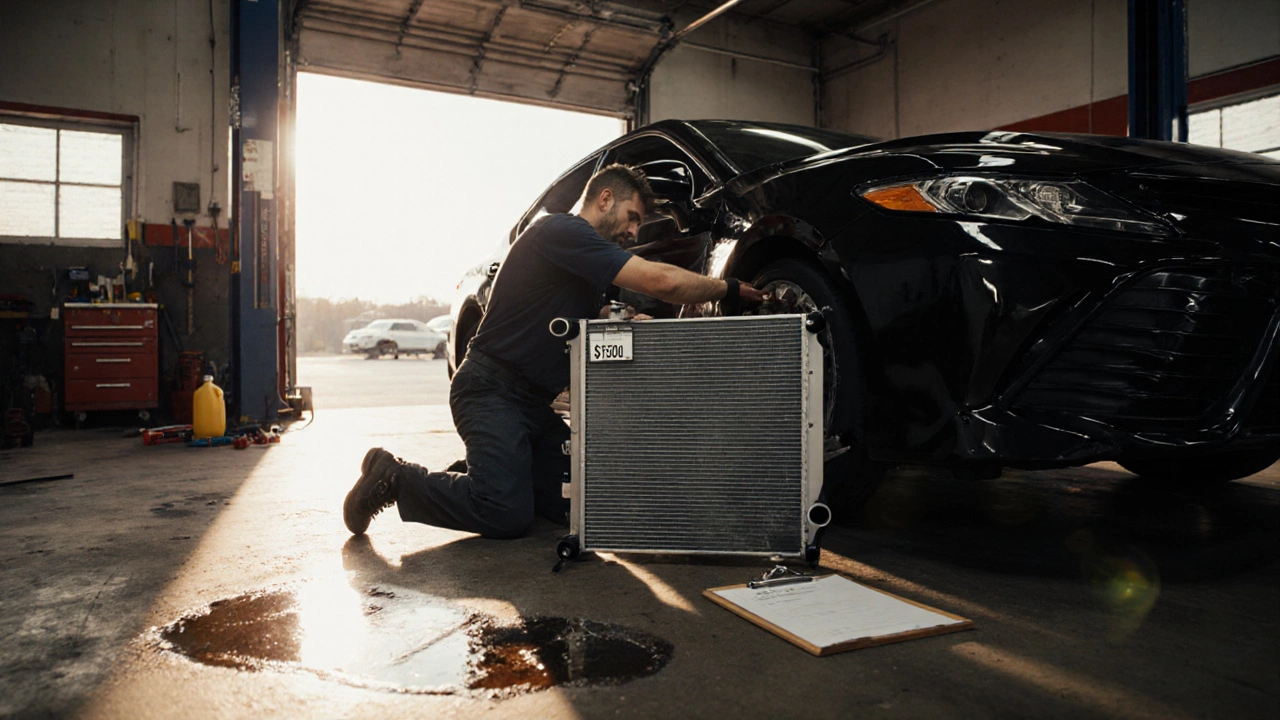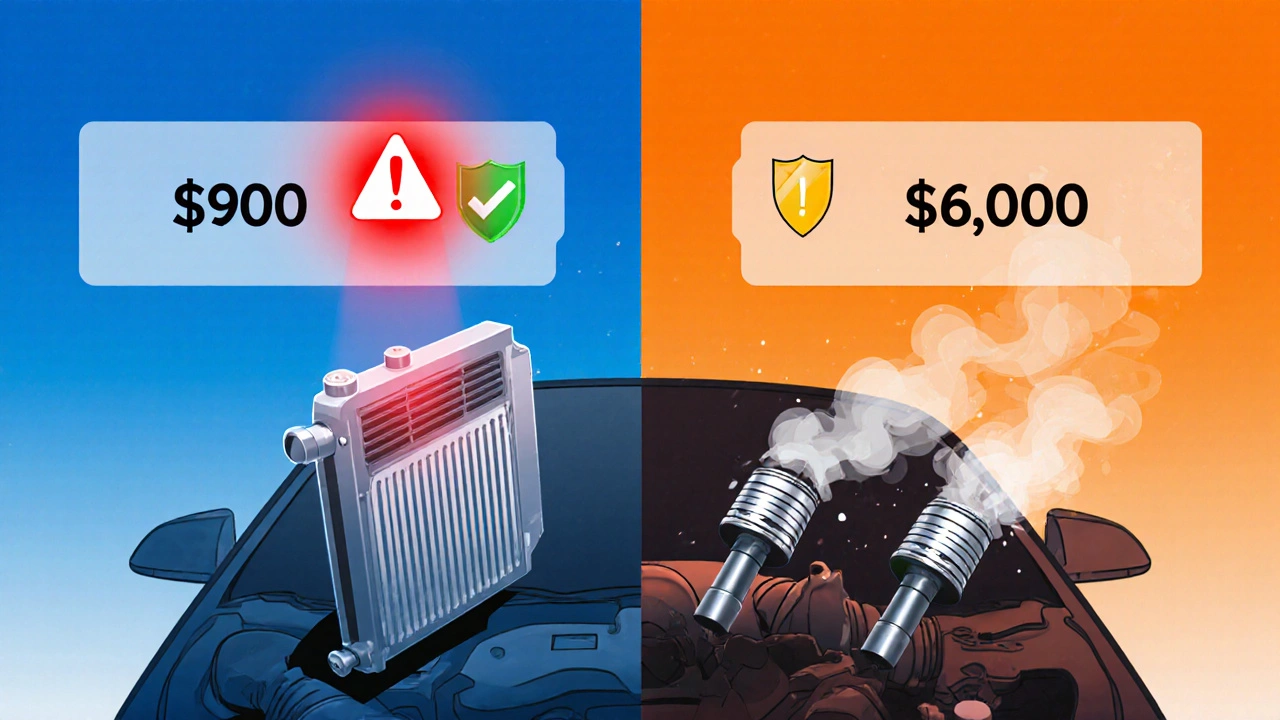 Nov, 20 2025
Nov, 20 2025
Radiator Replacement Cost Calculator
Estimate Your Radiator Replacement Cost
Calculate your specific radiator replacement cost based on vehicle type, location, and shop choice.
Estimated Cost Breakdown
$0Replacing a car radiator doesn’t have to break the bank-but it can if you don’t know what you’re paying for. In 2025, the average cost to replace a radiator in Canada ranges from $600 to $1,200, depending on your car model, where you live, and whether you go to a dealer or an independent shop. For a basic sedan like a Honda Civic or Toyota Corolla, you’re likely looking at $600-$800. For a luxury SUV like a BMW X5 or a truck like a Ford F-150, the price jumps to $900-$1,200 or more. That’s not just parts-it’s labor, coolant, and sometimes unexpected damage that adds up fast.
Why Radiators Fail (And Why It’s Not Always Your Fault)
Radiators don’t just wear out randomly. They die because something else went wrong first. Most failures come from one of three things: corrosion, leaks, or overheating caused by a bad thermostat or water pump. In places like Hamilton, where winters are harsh and roads get salted, rust eats away at aluminum radiator tanks and metal hoses. A small leak from a cracked plastic end tank can turn into a full-blown failure in just a few months if you keep driving.
Old coolant is another silent killer. Most manufacturers say coolant lasts 5 years or 160,000 km-but that’s only true if it was changed on time. If you haven’t flushed it since 2020, you’re running dirty fluid that turns acidic and eats metal. That’s why a radiator replacement often comes with a recommendation to replace the thermostat, hoses, and even the water pump. It’s not upselling-it’s smart prevention.
What’s Actually in the Price?
Here’s how the cost breaks down for a typical mid-sized car:
- Parts: $250-$500. OEM radiators (from the car maker) cost more than aftermarket ones. A genuine GM radiator might run $450, while a Spectra or Denso aftermarket unit runs $280-$350. You save money with aftermarket, but make sure it’s from a reputable brand.
- Labor: $300-$600. This varies wildly. A simple radiator swap on a front-wheel-drive car might take 2 hours. On a truck with a tight engine bay or a car with multiple fans and sensors, it can take 4-6 hours. Shops charge $95-$140/hour depending on location and expertise.
- Coolant and fluids: $40-$80. You need 5-8 liters of fresh coolant. Some shops use universal coolant; others use brand-specific fluid. Don’t skip this-it’s critical for engine life.
- Additional parts: $50-$200. If your hoses are brittle, the thermostat is stuck, or the radiator cap is leaking, you’ll need to replace them too. Many mechanics bundle this into the quote to avoid callbacks.
That’s why a $500 quote might turn into $900 by the time you leave. Always ask for a detailed breakdown. A trustworthy shop will list each item separately.
Dealer vs. Independent Shop: What’s the Real Difference?
Dealerships charge more-no surprise. A radiator replacement at a Ford dealership might cost $1,100, while an independent shop down the street does it for $750. But here’s what you’re paying for:
- Dealerships: Use only OEM parts. Technicians are factory-trained. They have access to specific diagnostic tools for your car model. Warranty coverage is usually included.
- Independent shops: Use high-quality aftermarket parts (like Mishimoto or Koyorad). Often faster service. More flexible pricing. Many have 2-year warranties on labor and parts.
For a 2018 Toyota Camry? Go independent. For a 2023 BMW with a complex electric cooling system? Dealership might be worth the extra $300. You’re paying for precision, not just parts.

When You Can Save Money (And When You Shouldn’t)
You can save on radiator replacement-but only if you’re smart about it.
- Savings tip #1: Get quotes from at least three shops. One in Hamilton, one in Burlington, one in Ancaster. Prices can vary by $150-$200 just based on rent and overhead.
- Savings tip #2: Buy the radiator yourself. Some shops let you supply parts and charge only labor. That could cut $200 off the total. Just make sure you get the right part number-don’t guess.
- Don’t save here: Skip the coolant flush. Don’t reuse old hoses. Don’t ignore the thermostat. These aren’t optional. A radiator replacement without a full cooling system check is like replacing a tire but leaving the rim bent.
One customer in Hamilton saved $300 by buying a $220 aftermarket radiator online and bringing it in. The shop charged $550 labor. Total: $770. Three months later, the hose cracked because they didn’t replace it. He paid another $400. You’re not saving-you’re just delaying the real cost.
Signs You Need a New Radiator (Not Just a Leak)
Not every coolant leak means you need a new radiator. But these signs do:
- White, milky sludge under the oil cap (coolant mixing with oil)
- Engine overheating even after a coolant refill
- Visible cracks or bulges in the radiator tank
- Green, orange, or pink fluid leaking from the bottom of the radiator (not the hoses)
- Steam coming from under the hood while idling
If you see any of these, don’t wait. Driving with a bad radiator can warp the cylinder head or blow the head gasket. That repair? $2,500-$5,000. A radiator replacement is the cheap fix.

What Happens If You Don’t Replace It?
Some people think, “It’s just a radiator. I’ll top off the coolant and keep going.” That’s how engines die.
When the radiator fails, coolant can’t circulate. The engine heats up. The head gasket seals start to break. Metal expands. Pistons seize. In extreme cases, the engine block cracks. That’s not repairable-you need a new engine. And that’s not a $1,200 job. That’s a $5,000-$8,000 job.
One mechanic in Hamilton told me about a 2017 Honda Accord that overheated for three weeks. Owner kept adding water. When it finally died, the head gasket was blown, the cylinder head was warped, and the timing belt had snapped. Total repair cost: $7,200. The radiator replacement? $700.
How to Extend Your Radiator’s Life
Prevention is cheaper than replacement. Here’s how to make your radiator last 15 years:
- Flush coolant every 5 years or 80,000 km-even if the manual says longer.
- Check coolant level monthly. Low fluid means a leak.
- Inspect hoses every oil change. Squeeze them. If they’re hard, brittle, or soft like a banana, replace them.
- Don’t ignore the temperature gauge. If it creeps into the red, pull over.
- Use the right coolant. Mixing types causes chemical reactions that eat your radiator.
These steps cost nothing but time. And they’ll save you thousands.
Final Thoughts: Is It Worth It?
Yes. Replacing a radiator is expensive-but it’s one of the most cost-effective repairs you can make. It’s not about the price tag. It’s about protecting your engine. A $900 radiator replacement today prevents a $6,000 engine rebuild next year. It’s not a luxury. It’s insurance.
If your car is running hot, leaking coolant, or you’re just not sure-get it checked. Don’t wait until steam is coming out of the hood. That’s when the real bills start.
How long does a radiator replacement take?
Most radiator replacements take between 2 and 6 hours, depending on the car. Simple models like a Honda Civic or Toyota Corolla can be done in 2-3 hours. Trucks, SUVs, or cars with tight engine bays (like some BMWs or Audis) can take 4-6 hours because of extra components blocking access.
Can I replace a radiator myself?
Yes, if you have basic tools and experience. You’ll need a wrench set, coolant drain pan, funnel, and a torque wrench. The job involves draining coolant, disconnecting hoses and electrical connectors, unbolting the radiator, and installing the new one. But if you’re not confident, don’t risk it. A wrong hose connection or air pocket in the system can cause overheating and engine damage. Most DIYers end up paying more to fix their own mistakes.
Is it cheaper to repair a radiator instead of replacing it?
Sometimes, but rarely. Small leaks in the end tanks can be soldered, and cracked plastic tanks can be patched-but these fixes rarely last more than a few months. In cold climates like Hamilton, thermal stress from freezing and thawing makes patched radiators fail again. Replacement is almost always the better long-term solution.
Do I need to replace the thermostat when replacing the radiator?
It’s strongly recommended. The thermostat is a simple part that costs $20-$50, but it controls coolant flow. If it’s stuck closed, your new radiator will overheat just like the old one. Most mechanics include it in the job because it’s a common failure point and easy to do at the same time.
What kind of radiator should I buy-OEM or aftermarket?
Aftermarket radiators from brands like Spectra, Denso, or Koyorad are reliable and often cheaper than OEM. Many are even upgraded with better cooling cores. OEM parts are exact matches and come with the carmaker’s warranty, but they cost 30-50% more. For most drivers, a high-quality aftermarket radiator is the smart choice.
How do I know if my radiator is leaking or if it’s a hose?
Look at the location of the leak. If coolant is dripping from the bottom of the radiator tank (not the hoses), it’s the radiator. If it’s coming from where a hose connects to the radiator or engine, it’s likely a hose or clamp. You can also pressure-test the cooling system-most shops do this for free or a small fee.
Can a bad radiator cause my car to overheat even with full coolant?
Absolutely. A clogged radiator, damaged fins, or internal corrosion can block coolant flow even if the tank is full. The coolant might be there, but it can’t circulate properly. That’s why overheating with full coolant is a classic sign of radiator failure-not low fluid.